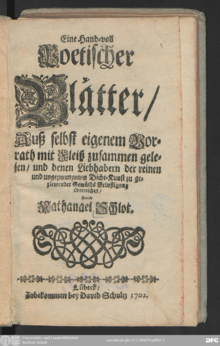Nathanael Schlott
Nathanael Schlott (born February 13, 1666 in Danzig ; † March 23, 1703 in Lübeck ) was a German teacher and poet of the Baroque era. He became known because of his high German version of the text of the Lübeck Dance of Death.
Live and act
Nathanael Schlott's parents are unknown. He attended the Academic Gymnasium Gdansk and held there on June 16, 1689 his final Latin speech about "Circa alapam caede vindicandam" . The treatise appeared in printed form as a school text . On May 27, 1691, he enrolled at the University of Jena . His occasional poems indicate that he still lived there in 1695.
On May 4, 1699, Schlott received Lübeck citizenship and worked until the end of his life as a preceptor of the poor and work house in the former St. Anne's monastery . The preceptors gave lessons and held prayer hours and services on Sundays and feast days. On May 15, 1699 he married Margareta Leopold in Lübeck. In his second marriage, he married Maria Elisabeth Arends there on July 4, 1701. Both marriages remained childless.
plant
Schlott became known in particular because of the Lübeck dance of death in the Marienkirche there . During a comprehensive renovation by the Lübeck church painter Anton Wortmann , Schlott was supposed to renew the Middle Low German verses, which were meanwhile difficult to understand and partly unreadable due to the change of language from Low German to High German, and convert them into High German. Since many people were engaged in the dance of death for centuries, the Alexandrines created by Schlott found widespread use. They are more of a free new version than a transfer of the text from the late Middle Ages. Schlott's texts were often printed without naming the author and largely without depicting the painting. Thomas Nugent translated the text in a travelogue into English. Jacob von Melle gave a positive judgment on Schlott's text. However, literary historians of the 19th and 20th centuries complained that the original text had been replaced. Schlott's verses judged this as mannered baroque. Hans Henny Jahnn , who visited the church in January 1915, praised Schlott's composure for its rhythm.
Schlott also wrote mostly occasional poems on the occasion of weddings and especially funeral services. He probably received the orders because of the dance of death. The poems did not get any appreciable reception. He published the collection of poems A handful of poetical sheets , which he dedicated to six Lübeck patricians, including Hermann Fock [e] and Hermann Rodde . This book contains mostly occasional poems and a second version of the dance of death, which he expanded to include the thesis “ Death is not a Tantz ” and the antithesis “ Death is a Tantz ”. Very few copies of this collection still exist.
There is evidence that Schlott wrote five funeral poems, each of which went to print. When the holdings of the Lübeck city library were relocated during the Second World War , these copies were lost. Two of these poems found their way into the Poetic Papers .
Schlott's occasional poems had no lasting literary meaning. Patricians and preachers in Lübeck and Jena probably valued him as a good funeral poet. The Killy literary lexicon judges that its occasional poems contain the learned rhetoric of the time , used in a measured and elegant manner .
Works
- Probabilism moralis, circa alapam caede vindicandam, succinctus examinatus. President: Johann Christoph Rosteuscher . Danzig 1689
- Lübeck Todten-Tantz, like the same, on the walls of the children's chapel in the Marien-Kirche, with the paintbrush of the artist, A. 1701, has been repaired, and decorated by him with new High German rhymes. Lübeck 1702
- Lübeckischer Todten = dance or dying = mirror , in: Hartmut Freytag (ed.): The dance of death of the Marienkirche in Lübeck and the Nikolaikirche in Reval (Tallinn): Edition, commentary, interpretation, reception. Cologne [u. a.]: Böhlau 1993 ISBN 3-412-01793-0 , pp. 363-3365
- A handful of poetic leaves [...] for lovers of the pure & natural. Handed over to casual poetry for appropriate mental amusement. Lübeck 1702.
literature
- Hartmut Freytag : Schlott, Nathanel . in: Biographical Lexicon for Schleswig-Holstein and Lübeck . Wachholtz, Neumünster 1982–2011. Vol. 9 - 1991. ISBN 3-529-02649-2 , pages 340-342.
- Hartmut Freytag (ed.): The dance of death in the Marienkirche in Lübeck and the Nikolaikirche in Reval (Tallinn). Edition, commentary, interpretation, reception. (= Low German Studies Volume 39). Böhlau, Cologne / Weimar / Vienna 1993, ISBN 3-412-01793-0 .
- Jürgen Rahtje / Red .: Schlott, Nathanael , in: Killy Literature Lexicon : Authors and works from the German-speaking cultural area. Volume 10: Ros - Se, Berlin: de Gruyter 2011 ISBN 9783110220438 , p. 427
Web links
- Publications by and about Nathanael Schlott in VD 17 .
- Publications by and about Nathanael Schlott in VD 18 .
Individual evidence
- ↑ a b c Hartmut Freytag: Schlott, Nathanel . in: Biographical Lexicon for Schleswig-Holstein and Lübeck . Wachholtz, Neumünster 1982–2011. Vol. 9 - 1991. ISBN 3-529-02649-2 , page 340.
- ↑ dodedans.com: Lübeck's Dance of Death - Thomas Nugent
- ↑ Hartmut Freytag: Schlott, Nathanel . in: Biographical Lexicon for Schleswig-Holstein and Lübeck . Wachholtz, Neumünster 1982–2011. Vol. 9 - 1991. ISBN 3-529-02649-2 , pages 340-341.
- ↑ a b c Hartmut Freytag: Schlott, Nathanel . in: Biographical Lexicon for Schleswig-Holstein and Lübeck . Wachholtz, Neumünster 1982–2011. Vol. 9 - 1991. ISBN 3-529-02649-2 , page 341.
- ↑ Jürgen Rathje: Schlott, Nathanael. In Killy Literature Lexicon (2012). Berlin, Boston: De Gruyter. Retrieved April 24, 2018, from https://www.degruyter.com/view/Killy/killy.5846
| personal data | |
|---|---|
| SURNAME | Schlott, Nathanael |
| BRIEF DESCRIPTION | German teacher and poet |
| DATE OF BIRTH | February 13, 1666 |
| PLACE OF BIRTH | Danzig |
| DATE OF DEATH | March 23, 1703 |
| Place of death | Lübeck |

